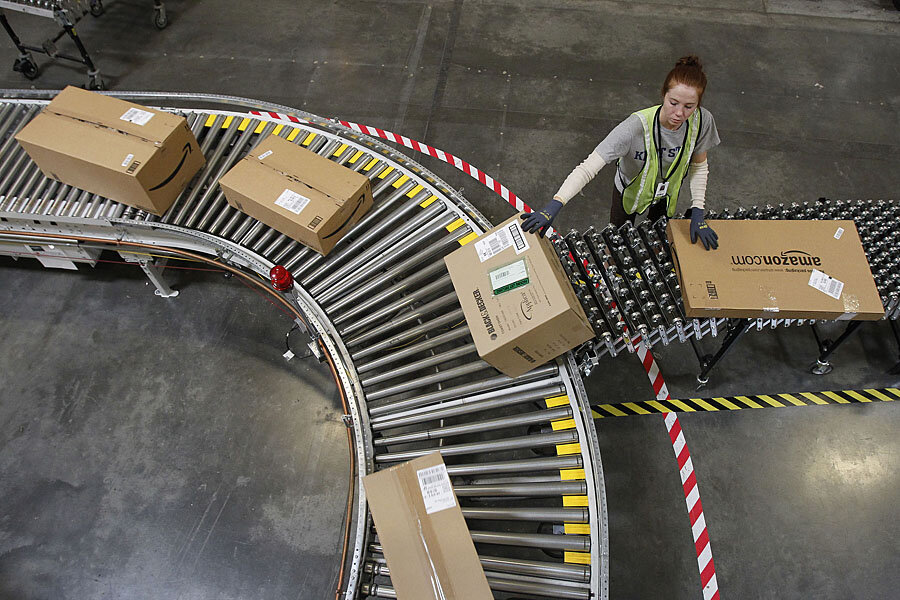Amazon to hire 80,000 extra workers for the holiday rush
Loading...
Amazon is hiring 80,000 seasonal workers for its distribution centers as it looks to improve its shipping efficiency during the crucial holiday season.
The figure is a 14 percent increase over last year's hiring of 70,000 workers, as Amazon has been opening more distribution centers.
It now has more than 50 distribution centers in the U.S., up from 40 last year. And in July it announced it was opening eight smaller sorting centers for a total of 15 by year-end. At the centers packages are sorted by ZIP code and then transported to U.S. Postal Service offices.
The company says the sorting centers help Amazon offer services such as Sunday delivery, a later cutoff order time and tighter control over shipping logistics.
Thousands of the seasonal jobs are expected to become permanent positions.
The pace of hiring at a retailer can serve as an indicator of expectations for the holiday shopping season, which accounts for 20 percent of the industry's annual sales, according to the National Retail Federation, a trade group.
Seattle-based Amazon is hoping to avoid problems that occurred late in the holiday season last year, when shippers such as UPS were caught off guard by spiking online orders, particularly from Amazon.com.
The hiring spree is just part of what are expected to be grand holiday plans for the e-retailer. Last week, reports surfaced that Amazon has plans to open its first physical retail store in midtown Manhattan. The store would act as an outpost for same-day pickup of online orders and customer returns and exchanges, as well as a showroom for Amazon's electronic products. Analysts see both great upside and great risk in the move, as Monitor reported Friday:
Some, predictably, are wondering why Amazon would want to venture into the brick-and-mortar retail space when it can compete with (and in some cases decimate) major big-box chains just fine without its own stores. The company’s flexibility is part of its strength – it doesn’t have to deal with the typical costs of managing retail spaces, allowing it to offer competitive prices on almost any product it pleases. Midtown Manhattan is an expensive place for an inaugural storefront. “Amazon’s value proposition is its huge selection and shipping that comes to me,” Forrester analyst Sucharita Mulpuru tells Forbes. “Both those aren’t going to happen at a physical store in Manhattan.”
In-store retail, too, has been losing ground to e-commerce for several years. E-commerce sales jumped 9.3 percent year-over-year during the 2013 holiday shopping season, making up $95.7 billion in total sales, according to the National Retail Federation. Growth for overall sales was a comparatively paltry 3.8 percent. “Cyber retail sales are increasing like gangbusters and we expect the clicks to make accelerated gains over the bricks,” IHS Global Insight economist Chris Christopher said in a January 2014 analysis.
Despite such gains, however, the overwhelming majority of retail purchases are still made in stores. E-commerce sales made up just 6.4 percent of total retail sales in the second quarter of 2014, according to the Commerce Department, and even at current growth rates it would take a long, long time for online sales to overtake in-store purchases. Amazon wouldn’t be the first online merchant to move into storefronts (clothiers Bonobos and Warby Parker, as well as the makeup subscription retailer Birchbox have all opened their own stores), though it would be the biggest.
But beyond another sales outlet, a physical store has the potential to be invaluable in terms of marketing. As New York magazine points out, Apple’s first store openings in 2001 were met with widespread skepticism; now, the frenzy around the company’s new product launches, with customers lining up around the block for the latest iPhone or iPad, have become news events in themselves. Apple stores are the most profitable retail spaces in the world, making about $39 million in revenue per store last year. Ebay and Microsoft have made their own moves into the physical retail space as well.
Overall, the National Retail Federation said it expects sales during the November and December period to increase 4.1 percent to $616.9 billion, up a percentage point higher than last year. It marks the highest increase since 2011 when the rise was 4.8 percent.
Amazon employs more than 132,600 full-time and part-time employees globally.







